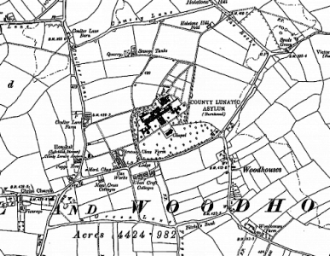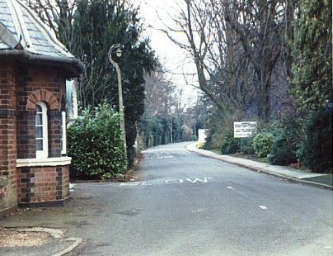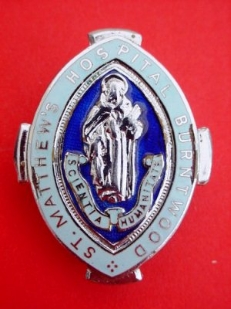Burntwood Asylum / Saint Matthew's Hospital
Burntwood Asylum was one of three asylums to be built in Staffordshire. The first was built in Stafford and later became St George’s Hospital. The second was built in Burntwood and later became St Matthew’s Hospital. The third was built in Cheddleton and later became St Edward’s Hospital.
Burntwood Asylum was built on an estate on Hobstone Hill to the east of Christchurch and north-west of Woodhouses. The purchase of the 94 acres of land cost £7,880. The architect was William Lambie MOFFATT (1807 – 1882) of Edinburgh, who was also responsible for the design of a number of public buildings in Leeds and Wakefield.
Burntwood Asylum Plan Burntwood Asylum Grounds
The asylum was built at a cost of £65,000 and was designed to be almost self-supporting. It had its own gas works, electricity plant, bakery, church, laundry, fire department, mortuary and a farm (Coulter Lane Farm) and gardens which provided the majority of the potatoes and vegetables for use in the hospital and also some rehabilitation for the inmates. It had much staff support, such as a boiler man, carpenters and gardeners. It even had its own orchestra. The asylum then completed consisted of the central block, including a chapel above the dining room, and the west wing containing the male wards, with a portion partitioned off for female inmates. The wards were very large, and many inmates would be crammed together in them.
The dining room
The chapel above the dining room was built to seat 315 people. It was later discovered that the centre beam was found to be insecure, due to the weight of a minaret campanile (a mechanical orchestra). By November 1867 the minaret campanile had been replaced by an organ, and the chapel was deemed to be complete and safe. Divine Service was held on Wednesday evening, Friday morning and on Sunday morning. About 138 male inmates and 44 female inmates attended.
Entrance to the asylum grounds was via the gatehouse. The main building was approached by a long drive, lined both sides with lawn and trees. There were many different varieties including Horse Chestnut, Lime, Oak and Pine. The asylum was built using red coloured bricks and the dome shaped windows were typical of Victorian design.
Gatehouse entrance
The asylum was built to hold 500 inmates but it was continually added to over time and eventually extended to 1302 beds. Burntwood Asylum opened on the 20th December 1864 with the admission of 122 inmates transferred from Chester. They were sent there on a temporary basis as the asylum at Stafford had no room for them. For the inmates there, work was part of the treatment regime. They would be employed in varying activities. The Men would work on the farm, as shoemakers, tailors and ward cleaners. Women would work in the laundry, kitchen or needlework and ward cleaners. Those inmates who were violent or may harm themselves were locked up in padded cells.
Asylum entrance
The cemetery was laid out in 1867 between Coulter Lane and St. Matthew’s Road, together with a small chapel. Later that same year, the cemetery was consecrated. It was extended in 1904, and was still in use up until the 1950's. There is an entry in the Burntwood Asylum Register of Graves held by Staffordshire Record Office stating "Stones made up to here:- 28th May 1913". No more stones were made for patients after this date, so the stones photographed below must predate this.
A total of 3,103 bodies were buried in the cemetery, 1,560 men and 1,543 women. The unused graveyard still exists but only a few scattered headstones survive. Some of those are inscribed with the dates of burials and the inmates’ initials. The few scattered headstones do not give a true picture to the number of graves in the cemetery.
Scattered Headstones in the Old Cemetery
Within the confines of the cemetery, there are also 9 war graves and headstones of local servicemen who fought and lost their lives in the First World War. These graves are maintained by the Commonwealth War Graves Commission. Burntwood Family History Group has photographed and transcribed the war graves and headstones.
One of the 9 CWGC Headstones
In 1868 the East Wing, which contained the female wards and another 30 beds was added to the complex. This brought the total accommodation to 530 beds.
In 1871, the total amount of inmates had risen to 491. There was a staff of 4 officers, 41 attendants and nurses, and 5 artisans.
In 1880 the Reverend T.B. MUNDY was Chaplain.
In 1881, the Medical Superintendent was James Beveridge SPENCE. He was aged 31 and married.
Over the years, the asylum had many extensions added to it. Three more female wards were erected in 1897, followed by two male wards in 1898. This was in addition to large bays being added to the existing wards.
The original chapel held its last service on the 14th August 1899. The construction of a new detached chapel in the grounds had already started, and it opened on Sunday the 7th January 1900. The chapel was later called St Matthew’s Church. There was also a small chapel in the cemetery which was demolished in the 1960's.
In 1914 a nurses' home was added to the complex.
During the First World War, Rubery Hill Asylum, Worcestershire and Berrywood Asylum, Northamptonshire, were both taken over as military hospitals. Inmates were transferred from these asylums to Burntwood.
In 1921 a clock, which was a gift from the WORTHINGTON family of Maple Hayes, was installed in the Tower. It was a square block at the top with a clock face on each side.
Clock in the tower
During the 1920’s, as elsewhere, social change affected Burntwood Asylum. The asylum was gradually becoming a Hospital. New Laboratories were built where doctors could conduct research into the causes and cure of lunacy. In 1924 an operating table was purchased.
Matron and her nursing staff. The nurses are wearing black bows in hounour of Queen Alexandra who died on 25th November 1925
In 1928 the asylum was referred to as 'St. Matthew's' but the name was not officially adopted until 1948.
In 1929, the Vestry was added.
In 1931, the Lych Gate was erected.
In 1939, the Ministry of Health's Emergency Medical Service Hospitals were set up for expected civilian casualties in air raids. Asylums were among the institutions that were incorporated in the scheme and Burntwood Asylum became one of them.
Patients were taken there from the Birmingham blitz, housed in Nissan huts within the grounds. And from 1940 to 1947 the asylum was used as an emergency hospital taking emergency military and civilian patients. The first patients were 242 sick and wounded evacuated from the beaches of Dunkirk.
Nursing staff with Dunkirk evacuees © Burntwood Chase Heritage Group
Occupational Therapy was introduced as treatment for the patients, and a formal Nurse Training School was opened in 1946.
In 1948, following the introduction of the National Health Service, Burntwood Asylum was transferred to the National Health Service and was officially renamed St Matthew's Hospital.
In May 1950, Joseph EVANS, R.N. 587, R.M.N. 8287 was the Chief Male Nurse at St. Matthew’s Hospital.
In 1951, the film ‘The Lady with the Lamp’ was released in cinemas. The leading star was Dame Anna NEAGLE portraying Florence NIGHTINGALE.
Dame Anna NEAGLE as Florence NIGHTINGALE
The following year, Dame Anna NEAGLE visited St Matthew’s Hospital and took with her the actual lamp she carried in the film. She posed with the lamp and members of staff. She then gave them the lamp as a gift, which the staff proudly displayed in the hospital.
(Dame Anna NEAGLE at Burntwood Asylum with the lamp and staff. And the lamp she gifted displayed)
In 1955 the Reverend C. C. D. LEWIS, Vicar of Burntwood, (see also) was also Chaplain to St. Matthew's Mental Hospital.
In 1956, the east window was installed in the chapel which depicted ‘Victory’. The same year burials in the hospital cemetery ceased.
A comment from Vivien KENT
'I thought you might be interested to know that I grew up in the house that stood adjacent to the entrance of the driveway to St Matthew's. My father was Dr Stephen KENT and he was the Deputy Medical Superintendent at the hospital until his death in 1968. Our house was called Lime Hay and I believe it was subsequently turned into flats. Patients of my father used to work for us as household help and gardeners as part of their therapy and I spent much of my childhood visiting the hospital and playing in the grounds. I left Burntwood in 1971 and remember it as a village surrounded by farmland, but I understand it has since merged with Chasetown and become a town the size of Lichfield'
A comment from Ann SHARMAN
'My father, John WALTERS, was Vicar of Burntwood and chaplain at St Matthews from about 1956 until he moved over to Harlaston. I particularly remember the installation of the WW2 window, and the removal of the pews, and the Italians who put down the terrazzo floor. We lived in the old Vicarage, which was demolished after I had moved on, and a new one built. I saw the start of the huge buildling programme in the area, although I attended the Friary school in Lichfield, so my focus was very much in that direction. I must come back and see what I recognise!'
In 1982 and 1991 respectively, if there had been large scale casualties in the Falkland war, or the first Gulf war, it was planned that they would have been taken to St Matthew’s Hospital, and the patients there at the time, moved out to other hospitals.
The first instance of a local church being used as a concert venue for the Lichfield Festival occurred in 1992, when St. John’s Hospital chapel in Lichfield and St. Matthew’s Hospital chapel in Burntwood were added to the roster.
In April 1995, St Matthew’s Hospital closed down after the government’s community care programme saw the transfer of psychiatric care into the community and patients were transferred to private establishments. The buildings were virtually abandoned and much of the contents were left in situ, including some of the nurses uniforms. A lot of the contents were stolen and the building deteriorated. Although the National Health Service took over the running of St Matthew’s Hospital in 1948, the buildings remained under the jurisdiction of the Ministry of Defence right up until its closure.
Prior to closing down, a grand party / reunion was held in the main hall of the hospital on the 18th February 1995. This was followed in the evening by a dance in the St Matthew’s Social Club.
The closure of St Matthew’s Hospital, which lay in the Green Belt on the eastern fringe of Burntwood necessitated consideration of appropriate alternative uses for the site. Following efforts by the Health Authority to dispose of the site, the Council accepted that there was little prospect of the sites re-use. It was therefore considered that the most appropriate re-use was for a residential development. The majority of the buildings were demolished. St. Matthew’s Social Club survived, as did the administration block and chapel.
In 1999 a new housing estate was built consisting of 332 houses. The surviving administration block which was of some architectural merit, was converted to modern apartments. A phased programme of redevelopment incorporated a range of house types and densities within each phase, and provided a total of nearly 400 dwellings. Established trees on the site were retained and managed.
Plan of Housing Estate
In 2003 the Chapel was acquired by Busy Bees Childcare Ltd as their Headquarters. They have in excess of 50 outlets.
The 21st of November 2010 saw another reunion at St Matthew’s Sports and Social Club, formally the hospital club which included a disco and buffet. Former Staff Nurses Shirley INGRAM and Shirley SEWELL, arranged the evening, which included a disco and buffet. Over 200 past members of staff attended the reunion.
In 2011, Ron BRADBURY of Chase Heritage Group met up with Ethel LOTE, an ex-nurse at St Matthew’s Hospital and she told him of her times there. Ron wrote an article which appeared in the Burntwood Post newspaper on the 3rd February 2011, together with two photographs she supplied. The article was entitled ‘Hospitals Vital Role in the War’.
‘St Matthew’s Hospital has long gone, but memories will remain for a long time. We forget just how much of an important part it played in the Second World War. An ex nurse who worked there for a long time told me that the buildings in the grounds, that once held the Dunkirk survivors, were still under the jurisdiction of the Ministry of Defence right up to the closure of the hospital.
The psychiatric patients housed in them would have been moved out had there been large scale casualties in the Falkland and first Gulf wars. One of the last surviving nurses from the Second World War is Ethel LOTE, now nearly 90. She tells me that when she first went to the hospital there were bombing victims from the Birmingham blitz housed in the Nissan huts in the grounds. These were moved out as whispers went around that a large number of soldiers were on their way to Burntwood.
She stood shocked as lorries, buses and ambulances came down the long drive full of sad-eyed young men with their uniforms sticking to their bodies. Most of the soldiers had only been in the army for three or four weeks before being sent off to France, only to return home via Dunkirk, and then on to Burntwood which must have been like paradise in its quiet country setting.'
Ethel LOTE © Ethel LOTE Ethel LOTE outside huts in the hospital grounds © Ethel LOTE
For those of you researching your family history, there are many sources of information.
Burntwood Family History Group has transcribed the burial records of the Burntwood Asylum / St. Matthew’s Hospital. Details of burials between 1867 and 1908 and a Burials Index between 1908 and 1956 they have been placed on CD. Also on the CD are the Census Returns for the asylum for the years 1871, 1881, 1891 and 1901. This CD, No. 18, can be purchased from the BFHG. Details of how to purchase this CD, and many other transcriptions from establishments in our area, can be seen on our webpage ‘Publications for Sale’.
Burntwood Family History Group has photographed and translated the 9 war graves and headstones of local servicemen who fought and lost their lives in the First World War, who are buried in the cemetery. These war graves and transcriptions can seen on our webpage 'Burntwood War Graves, St Matthew's Hospital'.
Burntwood Family History Group Member Sandra DICKINSON has provided us with a photograph of her grandfather Harold PARKER at St. Matthew’s Hospital. Sandra thinks that Harold was either at St. Matthew's Hospital on sick leave from the army, or had taken up work there as an Attendant after being demobbed. Not long after the photograph was taken, Harold became a coal miner. Details of Harold PARKER can be found on our webpage 'Harold PARKER'.
Harold PARKER is seated middle row second left © Sandra DICKINSON
Some of the records of Burntwood Asylum / St Matthew’s Hospital are held by the Staffordshire Record Office. This collection is strong both for administrative and patient records. The former include minutes of various committees up to the early 1960s, and the latter include admission registers and full patient case notes. There is a complete record of those who were buried in the hospital cemetery until 1956. Staff records date from 1866 but the fullest records are for the early 20th century. For the building itself, there is little from the 1860's but there are plans which show the development of the site and buildings from the 1890s through to the 1970s. Access to some documents is restricted. Medical records less than 100 years old are not normally accessible for consultation by the public.
Records can also be accessed at The National Archives.
Books have been written and published about the Burntwood Asylum / St. Matthew’s Hospital, or contain information about it:-
‘A County Lunatic Asylum: The History of St. Matthew's Hospital (Burntwood)’ (Paperback) written and published by David BUDDEN.
‘This Won’t Hurt! – A History of the Hospitals of Lichfield’ written by Mary HUTCHINSON, Ingrid CROOT and Anna SADOWSKI.























